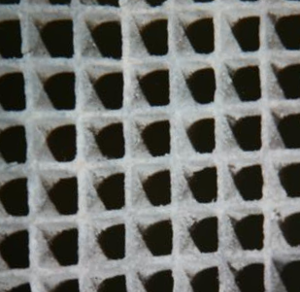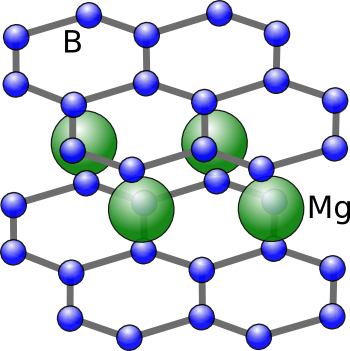Magnesium Diboride
November 2, 2015
While
labor cost typically dominates the more mundane things in our lives, like
automobile repair, the cost of some
advanced technology items are set by the expensive
materials they contain. One example is the
catalytic converter that's found in every
internal combustion automobile. You can tell that automotive technology has advanced, since a
decade ago I would not have needed to preface "automobile" with "internal combustion" in the last sentence.
Catalytic converters have been required since the
mid-1970s as a means of reducing
air pollution from unburned
fuel and
nitrogen oxides. As I wrote in a
previous article (Faux Palladium, January 14, 2011), the principal active materials in these converters are
platinum and
palladium. While palladium is relatively unknown outside of technical circles, everyone knows that platinum is expensive.
The current price for platinum is about $950/
Troy ounce. About 160 million
metric tons of platinum were
mined in 2014.[1] The current palladium price is about $600/Troy ounce. About 190 million metric tons of palladium were mined in 2014.[1] For price comparison, the current price of
gold is about $1,100/Troy ounce.

Detail of the core of a catalytic converter.
The catalyst is on the surface of a ceramic body that allows sufficient exhaust gas flow while maintaining enough residence time for the catalysis to proceed.
(Wikimedia Commons image by Global-Kat Recycling, modified.)
Platinum and palladium aren't the only expensive materials in an automobile. Our
motorized windows,
doors,
door locks, and the
loudspeakers on our
radios, all contain
magnets made from
rare-earth metals. In 2014,
China mined 95 million metric tons of
rare earth oxide equivalents, from which rare earth metals are refined, of the world's total production of 110 million metric tons.[2] In 2012, the last year for which data are available, the oxide of
neodymium, the rare earth from which the
best magnets are made, sold for $117/
kilogram.[3]
Rare earths are also a component of some
high temperature superconductors. The mechanism for
superconductivity in these materials is apparently by
electron-electron interaction, as distinct from the
phonon-electron interaction of conventional (
BCS theory) superconductors. The later achieved superconducting
temperatures as high as 30 K before the discovery of the superconductivity of
magnesium diboride (MgB
2) with a superconducting temperature of 39 K.

Structure of magnesium diboride, MgB2
The magnesium atoms sit between the holes of the boron hexagonal layers.
(Created with Inkscape.)
Since magnesium diboride is a
brittle material, it's made into superconducting
wire by many of the same processing techniques used for high temperature superconductors. However, it has the advantage that its
alloying elements are common and inexpensive.
Magnesium is found at a
concentration of about 25,000
ppm in
Earth's crust, and slightly less than a million metric tons of magnesium were produced annually worldwide in 2014.[4] While
boron is less abundant, about 10 ppm, about 3.75 million metric tons of boron were produced annually worldwide in 2014.[5]
Interestingly, magnesium diboride was discovered to be a superconductor only in 2001, many years after its first
synthesis and
characterization in 1953.[6-7] The
melting point of magnesium is 652
°C, so MgB
2 is synthesized quite easily by heating a mixture of boron (melting point, 2076 °C) up to that temperature and letting the
exothermic reaction heat the material until the
compound is completely formed. The product is MgB
2 powder.
Strong
magnetic fields will kill a material's superconductivity, but so-called
type-II superconductors are somewhat resistant to this effect. That's good, since the primary application of superconductors is the generation of large magnetic fields. Magnesium diboride is fortunately a type-II superconductor; and, as is commonly true for superconductors, small alloy additions can allow superconductors to function at even higher fields.
Carbon, since it has an
atomic size close to that of boron, will substitute for boron in MgB
2. Just a 5% substitution of carbon for boron more than doubles the ability of MgB
2 to withstand a magnetic field.[8] In theory, this allows the creation of one
tesla (10,000
gauss) magnets that operate at 25
kelvin (K), a temperature at which
liquid hydrogen (
boiling point, 20 K) can be used as a
refrigerant instead of
liquid helium.
Magnesium diboride is interesting since it sits between the conventional (BCS) superconductors and the high temperature superconductors.
Theorists at
Lawrence Berkeley National Laboratory and the
University of California, Berkeley, found that the odd features of MgB
2 superconductivity arise from two separate populations of electrons residing in two different kinds of
bonds among the atoms.[9-10] These two different types of bonds can be seen in the
schematic of the MgB
2 structure, as pictured above.
The
hexagonal honeycomb layers of boron atoms that sandwich layers of magnesium atoms in MgB
2 are bonded like a
plane of
graphite. However, boron has one electron less than carbon, and that's what causes the unusual electron distribution in the material. Since the
sigma bonds in the boron plane are only partially filled,
lattice vibrations - the
phonons in the phonon-electron interaction - have a much large affect.[9-10] This insight into how a layered structure helps to achieve superconductivity at higher temperatures might lead to the discovery of other high temperature superconductors.[10]
References:
- Mineral Commodity Summary, Platinum-Group Metals, United States Geological Survey Web Site.
- Mineral Commodity Summary, Rare Earths, United States Geological Survey Web Site.
- 2012 Minerals Yearbook (February, 2015), United States Geological Survey Web Site.
- Mineral Commodity Summary, Magnesium Metal, United States Geological Survey Web Site.
- Mineral Commodity Summary, Boron, United States Geological Survey Web Site.
- Morton E. Jones and Richard E. Marsh, "The Preparation and Structure of Magnesium Boride, MgB2," J. Am. Chem. Soc., vol. 76, no. 5 (March, 1954), pp 1434-1436, DOI: 10.1021/ja01634a089.
- Jun Nagamatsu, Norimasa Nakagawa, Takahiro Muranaka, Yuji Zenitani. and Jun Akimitsu, "Superconductivity at 39 K in magnesium diboride," Nature, vol. 410, no. 6824 (March 1, 2001), pp. 63-64, doi:10.1038/35065039.
- Taking superconductors to new heights, DOE/Ames Laboratory Press Release, June 28, 2004.
- Hyoung Joon Choi, David Roundy, Hong Sun, Marvin L. Cohen, and Steven G. Louie, "The origin of the anomalous superconducting properties of MgB2," Nature, vol. 418, no. 6899 (August 15, 2002), pp. 758-760, doi:10.1038/nature00898.
- Paul Preuss, "A Most Unusual Superconductor and How It Works," Lawrence Berkeley Laboratory Press Release, August 14, 2002.
Permanent Link to this article
Linked Keywords: Direct labor cost; automobile repair; advanced technology; material; catalytic converter; internal combustion engine; automobile; decade; mid-1970s; air pollution; motor fuel; nitrogen oxides; platinum; palladium; Troy ounce; metric ton; mining; mined; gold; catalyst; ceramic; exhaust gas; fluid dynamics; flow; residence time; Wikimedia Commons; electric motor; motorized; window; door; door lock; loudspeaker; radio; magnet; rare earth element; rare-earth metal; China; oxide mineral; oxide equivalent; neodymium; neodymium magnet; kilogram; high-temperature superconductivity; high temperature superconductor; superconductivity; electron; phonon; BCS theory; temperature; magnesium diboride; crystal structure; magnesium; atom; boron; hexagon; hexagonal; Inkscape; brittleness; brittle; wire; alloy; alloying element; concentration; parts-per notation; ppm; abundance of elements in Earth's crust; boron; chemical synthesis; physical property; characterization; melting point; Celsius; exothermic reaction; chemical compound; powder; magnetic field; type-II superconductor; carbon; atomic radius; atomic size; tesla; gauss; kelvin; liquid hydrogen; boiling point; refrigerant; liquid helium; theory; theorists; Lawrence Berkeley National Laboratory; University of California, Berkeley; chemical bond; schematic; hexagonal; honeycomb; plane; graphite; sigma bond; lattice vibration.